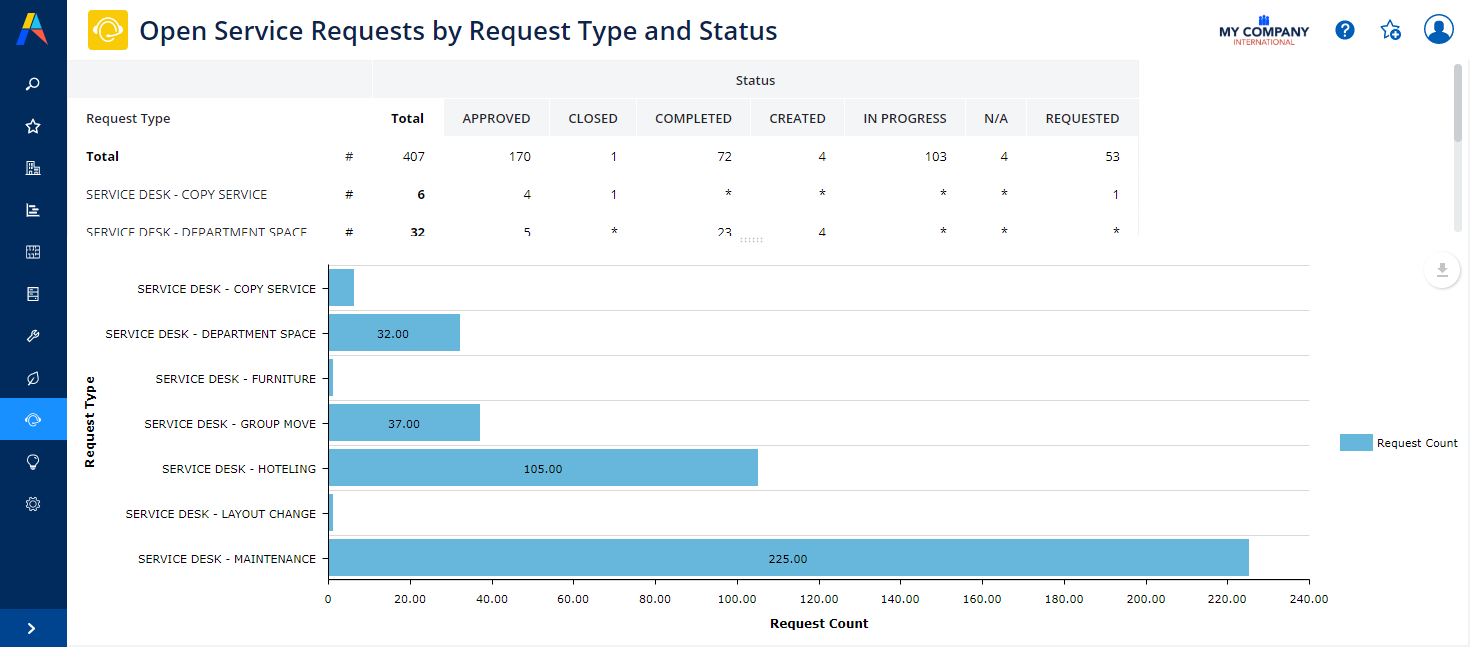Getting Results with Archibus
Service Desk
In order to provide an efficient workplace environment for their staff, many organizations offer a Service Desk to which employees can request services that improve their working environment, facilitate their day-to-day functions, and handle occasional requests. For example, a service desk might provide services for copying documents, arranging catering for a luncheon meeting, making travel arrangements, resolving IT requests, and so forth. The organization typically handle these tasks with a combination of internal staff and outsourced service providers.
The Archibus Service Desk application automates the management of a request to the organization's Service Desk. A staff member entering a request, a manager approving it, an external service provider addressing the issue, and the requestor recording their satisfaction with the completed work, all log into the Web, receive their appropriate assignment, and use tab-based forms to update the system.
The Service Desk application automates the service request cycle and routes work to the appropriate parties by following a workflow that is defined by a service level agreement (SLA). For various combinations of request types, priorities, requestors, and other factors, an SLA routes the work and defines such functions as the levels of approval, the notifications sent, the response time, and whether or not a satisfaction survey is generated. Workflow definers can define the SLA right from the Web interface by working through a series of tabbed forms.
Note: Corrective maintenance workflow is also determined by Service Level Agreements. Use the SLA features of the Corrective Maintenance application to develop SLAs for maintenance work.

|
Service Desk |
|
|---|---|
|
Location |
This is available in both Archibus SaaS and the Archibus non-SaaS offering.
|
|
Business Result |
A self-service interface for employees to request the workplace services that they need in order to effectively do their work. A system for automatically routing work to internal departments and external vendors. A system for capturing expense data by line of business, type, and account in order to perform accurate cost accounting. An automated method for escalating unaddressed work. |
|
Used By |
Internal staff Internal managers Internal and external service providers Service contract managers Service Desk managers Business managers |
|
Reasons for Automating |
Improve employee productivity as can efficiently request workplace services. Improve employee satisfaction with working environment, as employees have power to request services, follow their status, and record their satisfaction with completed work. Eliminate duplicate service requests. Reduce the number of inappropriate requests by expressing costs and approvals of items to requestor before requests are submitted to system. Reduce administration by implicitly expressing corporate policy with respect to authorization for moves, purchase, etc. Reduce administrative overhead by allowing internal staff to enter the details of requests themselves. Increase speed of response. Reduce operations costs, and increase accountability for costs. Reduce latency in inter-personal and inter-department workflow. |
|
Prerequisites |
None |
|
Reports |
Satisfaction Survey Results Costs of Open/Archived Service Requests Escalated Service Requests Service Provider Performance Service Request Type Performance |
|
Applications Using the Results of this Application |
Space Inventory (Transaction method) Workplace Services Portal mobile app |
The following are users of the Service Desk application:
|
User |
Tasks |
|---|---|
|
General Staff (Client) |
Report services that they require for their workplace environment. General staff with access to the Workplace Services Portal mobile app can request these services directly from their smart phone or mobile device. You can also request services using the self-service Workplace view. |
|
Business Manager |
Approve and reject service requests routed to them. |
|
Service Provider |
Accept and decline service requests routed to them. Issue service requests, execute the work, and update the system with details. Review service provider performance reports. |
|
Service Contract Manager |
Electronically record the details of service contract documents between the organization and service providers. Update Service Level Agreements. Analyze service provider performance. |
|
Service Desk Manager |
Define how the system routes and handles service requests by defining request types and service level agreements. Review escalated service requests and interfere in the defined workflow as necessary. Close completed service requests. Archive closed service requests. |
|
Business Process Owner |
Enter lists of data from which users can choose when completing forms. For example, building locations, service contracts, and accounts. |
|
System Integrator |
Manage the options available to the Service Desk Manager for defining Service Level Agreements (SLAs). |